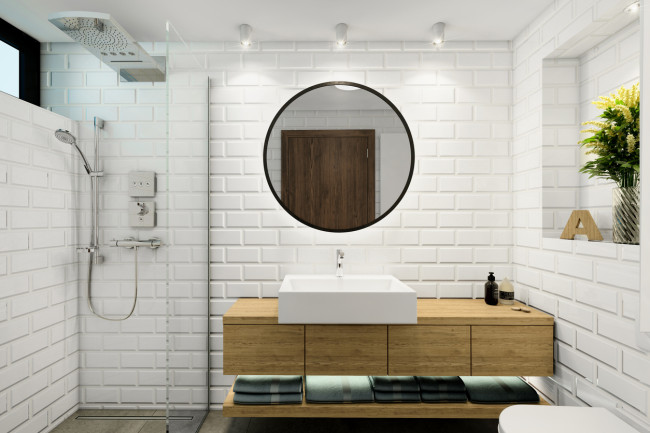What not to skimp on when renovating your NYC kitchen

The owners of this kitchen splurged on an island and deep cabinets, and saved with an IKEA butcher block countertop.
Ready to finally tackle that much-needed (or long-desired) kitchen renovation but don’t have unlimited funds for the project? Few people do, which is why it’s helpful to know where you can choose to spend less without compromising quality too much, and where skimping is a bad idea, with consequences ranging from eternal irritation to big expenses down the road.
We talked to home renovation experts and contractors to get the scoop on how to safely save some cash during your kitchen renovation and what you should never, ever skimp on.
Skilled labor
As discussed in our previous story on not skimping on bathroom renovations, hiring the most qualified and experienced professionals is key. While you should evaluate proposals and bids with a somewhat skeptical eye, opting for the lowest bid could result in sub-par work (or cost overages once the project is underway when you can’t do much about them).
Consequences of using less-than-experienced professionals can be expensive, and even dangerous. (Think faulty plumbing and all that entails, or blown fuses and fire from bad electrical work.)
Safety aside, the work will also look better.
With “a licensed general contractor or plumber, or a millworker—quality workmanship holds up over time,” says Jean Brownhill, founder and CEO of Sweeten, a free service that matches renovators with general contractors. “If you're the type of person who will notice an imperfect paint job, by all means, invest in that so you can keep your sanity."
The big one: cabinets
Experts we spoke to were unanimous in saying that you don’t need to spend a fortune on cabinets to get a quality product.
“Custom cabinets deliver the highest level of satisfaction, especially if you want the units to fit your space precisely, for a truly built-in look,” says Dan DiClerico, smart home strategist and home expert at HomeAdvisor. “But nowadays you can find solid construction, including dovetail joinery and full-extension drawer guides, in reasonable semi-stock cabinets, so that’s a good middle-of-the-road option.”
And as noted in our story on souping-up IKEA cabinet bodies with custom doors, the IKEA kitchen product is actually very well made.
However, you should not go with the bottom of the barrel, or what Michael Hershkowitz, president of REDOnyc, calls “rental cabinets,” which look good on day one and quickly go downhill from there. “It’s a very big mistake,” he says. “It’s going to fall apart—Period. End of report. You put them next to the stove, they start melting.”
“Cabinets and counters get the most wear and tear. The lifespan of your kitchen is determined by the quality of the materials. Cheap material, like particle board for cabinets might only give you a couple of years before it starts to deteriorate,” says Barbara Kovovit, CEO and president of Evergreen Construction.
It’s important to keep in mind that your cabinetry is an element of your kitchen that you’ll presumably use every day, so it’s worth making sure you install a quality product. “A cabinet drawer that sticks from day one, or a door that’s falling off its hinge after just a few months is guaranteed to drive you crazy,” says DiClerico.
Pay attention to the floors
Another spot to invest if you can is the kitchen floor.
“Cheap flooring: just don't do it,” says Brownhill “Flooring can be extremely hard to upgrade later and can undermine other smart material decisions. This doesn't mean you have to buy the most expensive, just don't get the cheapest, either.”
DiClerico agrees. “If you’re going for the timeless look of wood floors, it’s worth splurging on real wood planks, versus one of the many faux products out there,” he says. “For starters, nothing beats the warmth and beauty of natural wood. On top of that, solid floors can be refinished several times, so they’re probably the last floor you’ll ever install. Laminate flooring, by comparison, costs a lot less, but there’s no mistaking it for the real thing, and it can’t be sanded down and refinished, so its inferior look will only get worse over time.”
Spend where your needs are
Beyond these basic guidelines, it’s helpful to consider how you use your kitchen, and allocate dollars to that end. Do you cook or bake a lot? You may want to invest in a high-quality stove. Have kids? Hershkowitz recommends installing robust cabinets that can handle the abuse of children opening and closing them roughly. Tight on space? A custom corner piece to maximize every square inch could have a huge impact on what it feels like to work, and be, in a kitchen.
Finally, Kovovit is a big fan of considering how you’re lighting your kitchen.
“I always say it’s important to invest in great lighting. Light fixtures can really make or break the ambiance of a kitchen,” she says. “A couple of dollars reallocated to your lighting budget can make a huge difference in the overall aesthetic.”


























